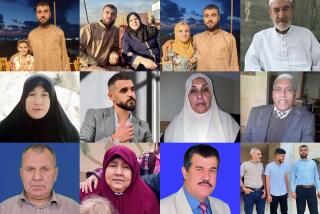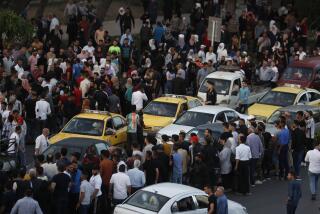U.S. Kills Hussein’s Sons in Firefight at Mansion
- Share via
MOSUL, Iraq — Acting on a tip from an Iraqi informant, U.S. forces backed by rocket-firing helicopters stormed a luxury home on the outskirts of this northern city on Tuesday. After a six-hour operation they removed the bodies of two of the most hated and feared men in Iraq: Saddam Hussein’s sons Uday and Qusai.
Two other Iraqis were killed in the assault. Residents of the neighborhood said they were a bodyguard and a teenager, believed to be Qusai’s son. U.S. officials said they were still unsure of that pair’s identity.
But Lt. Gen. Ricardo Sanchez, the American commander in Baghdad, said they were sure about Hussein’s sons.
“We are certain that Qusai and Uday were killed today,” Sanchez said at a news conference. “The bodies were in such a condition where you could identify them.”
The two brothers ranked second only to their father in the deposed regime and shared his reputation for the brutal exercise of power. They were Nos. 2 and 3 on the list of most-wanted Iraqis compiled by the U.S. military. In recent weeks, the Pentagon offered $15 million for information leading to the capture of each brother.
The deaths of Uday, 39, and Qusai, 37, mark a strong blow to the morale of fighters from the former regime still resisting the American-led occupation, U.S. defense officials said. The resistance movement has been fueled in part by rumors that Hussein and his sons were alive and directing the battle.
News of the killings spread rapidly across Iraq. Red, white and green tracers were visible across the moonless Baghdad skyline as many residents went to their rooftops or yards to fire automatic weapons in celebration. But some members of the public vowed that the death of the pair would not end the resistance to the U.S.-led occupation.
In Washington, L. Paul Bremer III, the top U.S. civilian administrator for Iraq, told reporters during a visit to Capitol Hill: “It’s a great day for the Iraqi people and a great day for the American military, who showed their astounding professionalism in this operation.”
President Bush “was pleased to hear the news,” White House Press Secretary Scott McClellan said. “Uday and Qusai were two leaders of a very brutal regime, and this is further assurance to the people of Iraq that the regime is gone and will not be back.”
Bush is scheduled to discuss operations in Iraq during an appearance in the Rose Garden this morning.
As pieced together from witnesses and military spokesmen in Mosul, Tuesday’s action began before 9 a.m. when troops of the Army’s 101st Airborne Division surrounded the imposing columned house of wealthy businessman Nawaf Zaidan, who claimed kinship to Saddam Hussein and reputedly had been involved in business dealings with the two sons.
According to Brig. Gen. Frank Helmick, deputy commander of the 101st Airborne, the division had received “actionable intelligence” the night before that “high-ranking members of the former government” were using the home. In Baghdad, Sanchez said an unidentified Iraqi had approached U.S. forces with the information.
A witness at the scene said a small group of soldiers took Zaidan into custody and put him in an Army vehicle near the house with his hands bound in plastic cuffs. Zaidan was heard urging the soldiers not to search the house because they would meet fierce resistance.
While the discussion was taking place, gunfire erupted from the house directed at the soldiers. The small-arms fire began from the roof and then came from the rest of the building. The soldiers called in scores of reinforcements.
U.S. troops stormed the abandoned first floor of the house but were initially unable to penetrate the “hardened” second floor, where the Iraqis had barricaded themselves behind bulletproof windows and other materials, defense officials said.
“We proceeded to wear away at their will to resist until the point came, late in the day, where we entered their house,” said Maj. Hugh “Trey” Cate, a public affairs officer for the 101st Airborne. That was around 1:30 p.m., he said.
Helmick said that when the people barricaded inside did not surrender in the face of small arms and .50-caliber machine guns, “we had to use bigger caliber weapons.” Brought to bear on the house were wire-guided TOW missiles, rockets fired from Kiowa OH-58D light assault helicopters and Mark 19 automatic grenade launcher systems.
The resulting mismatch was exactly what the Army wanted, Helmick said. He expressed pride in the accuracy of the fire, which decimated Zaidan’s house but left other buildings in the neighborhood unscathed except for broken windows and bullet and fragment holes in their rooftop cisterns.
“Doggone it, Americans should be proud of these soldiers,” he said.
Helmick said the troops were careful to avoid harming a large mosque across from the Zaidan residence. At the time the siege of the house began, the soldiers set up a cordon in the neighborhood, stopping people from attending noon prayers at the mosque for their own safety.
Ahmad Shakur, a local journalist who had watched the siege while lying on the ground near the mosque, said that for several hours it was “a battle zone.” Ten rockets were fired from the Kiowa helicopters, he said. Soldiers said at least 13 TOW missiles were fired as well.
Four American soldiers were wounded in the assault, and two Iraqis in the surrounding Al Falah neighborhood were killed.
After the guns inside the house fell silent, U.S. forces entered the premises. Witnesses said four bodies were carried out, three in sheets or blankets and one by his hands and legs. The corpses were loaded onto a helicopter and flown away, they said.
Hours after the battle, the asphalt outside the home was littered with shell casings from the .50-caliber machine guns that ripped into the heavy concrete casing of Zaidan’s home.
Shakur said soldiers and plainclothes officials removed computers, televisions and other items from the house, apparently seeking further clues in the hunt for other top officials of the former regime, including Saddam Hussein, who authorities believe is alive and most likely hiding in Iraq. The U.S. has offered a $25-million bounty for the older Hussein.
Defense officials would not confirm whether the reward for the death of the sons would go to the Iraqi who led U.S. forces to the Mosul house, but Sanchez said the money would “probably” be paid out. One defense official said of the informant: “He’s potentially $30 million richer.”
Leery of being proved wrong, U.S. officials were initially cautious Tuesday about declaring that two of the dead were Hussein’s sons. The bodies were flown to the town of Baiji, about 100 miles to the south, Sanchez said. DNA samples were taken for comparison with samples previously obtained.
But several Iraqis who knew Uday and Qusai were shown the bodies during the day, including Saddam Hussein’s top bodyguard and advisor, Abid Hamid Mahmud Tikriti, who was captured by U.S. forces last month, a State Department official said.
Mahmud was the top former regime official to verify the identities of the two bodies, said the official, who requested anonymity.
The sons could be positively identified by DNA testing in little more than a day, depending on the level of statistical certainty that officials sought in making the identifications, said professor James Starrs, a forensic science specialist at George Washington University.
A U.S. official in Washington said that in addition to the tip from the Iraqi, Tuesday’s raid was “prompted by a variety of kinds of intelligence,” suggesting that the U.S. had intercepted communications or imagery that helped pinpoint the location.
“There are multiple things which led us to believe there might be somebody there, multiple ‘ints,’ ” the official said, using spy community shorthand for signals, imagery and human intelligence.
Though soldiers at the site of the shootout were under orders not to speculate on who had been inside, they had a hard time suppressing their excitement about being a part of getting two top targets of the U.S. military.
“I think the soldiers are pretty pumped up. It’s good to accomplish a mission and not lose a life,” Cate said. “Anytime you do something big and important for the coalition and for its success in the country, that would make anyone happy.”
“It’d be good” if the dead were Hussein’s sons, said Maj. Frank Sturek, executive officer of the 101st Airborne’s 2nd Brigade, before the deaths were announced. “That may stop some of the violence” against U.S. forces, he said.
Hundreds of Iraqis from the neighborhood congregated throughout the day on the other side of the barbed wire to watch the Americans and glare at the heavily damaged house, its carved columns now blasted down to reveal the reinforced steel bars inside the concrete. Window frames hung askew and the interior was charred.
When asked about the possible deaths of Uday and Qusai, people in the crowd gave mixed responses.
“Even if Saddam Hussein is dead, half of Iraqis will be Saddam Husseins!” shouted one man, before walking away.
Another man, who gave his name only as Abu Ibrahim, disagreed. “Saddam Hussein killed millions of people,” he said. “The homeland is more important to us than any single person.”
Zaidan, the owner of the house, is the brother of Salah Zaidan, leader of the Bajat tribe in Iraq. Hussein, like the Zaidan brothers, is a member of the Albo-Nasr branch of the Bajat tribe.
Although the Hussein family and the Zaidans are linked by those tribal associations, several neighbors said the Zaidans had been persecuted by the former regime under a law that made it illegal to claim kinship to Saddam Hussein.
Despite that apparent conflict, neighbors also said that Nawaf Zaidan’s relations with both brothers had been cordial in recent years and that his economic fortunes had improved commensurately. They said Zaidan was the contractor for a massive mosque that Saddam Hussein ordered built in Mosul, the nation’s third-largest city.
Mosul, an ethnically diverse city bordering the autonomous Kurdistan region, is well out of the “Sunni triangle,” the region north and west of Baghdad where resistance to the U.S.-led occupation has been strongest.
One of the U.S. Army noncommissioned officers helping to secure the Zaidan home after the gun battle said he believed that he may have seen Uday Hussein in the same part of town Monday, riding in a dark-green or blue BMW next to his Humvee.
Sgt. Joshua Gilbreth of Fresno said he noticed the man looking at him, and when Gilbreth stared back, the man smiled and waved, and then the car sped away. At the time, Gilbreth thought he recognized the man as Uday, because he had been handing out wanted posters. He told his buddies right away, he said, but they all thought that he was joking.
A dark blue BMW sedan was parked in front of Zaidan’s house Tuesday, riddled with bullets from the fierce gun battle.
“I went over and looked at it,” Gilbreth said, “and I think it’s the same car.”
*
Times staff writers Esther Schrader, Robin Wright, Aaron Zitner, Greg Miller and Maura Reynolds in Washington and John Hendren and David Zucchino in Baghdad contributed to this report.
More to Read
Sign up for Essential California
The most important California stories and recommendations in your inbox every morning.
You may occasionally receive promotional content from the Los Angeles Times.










